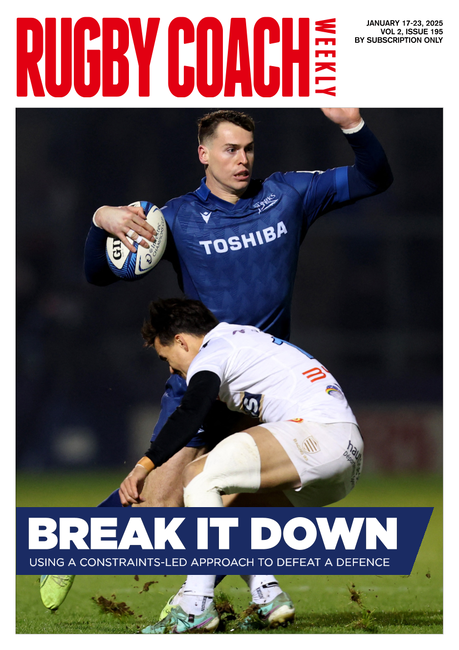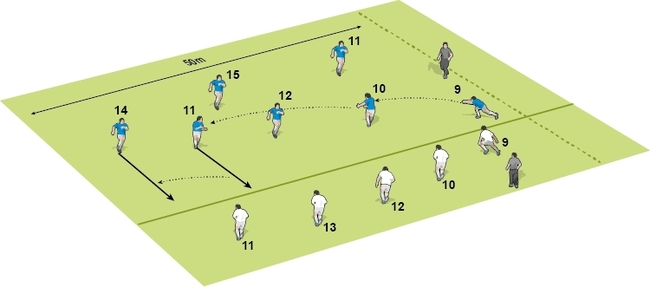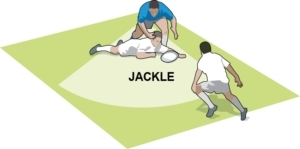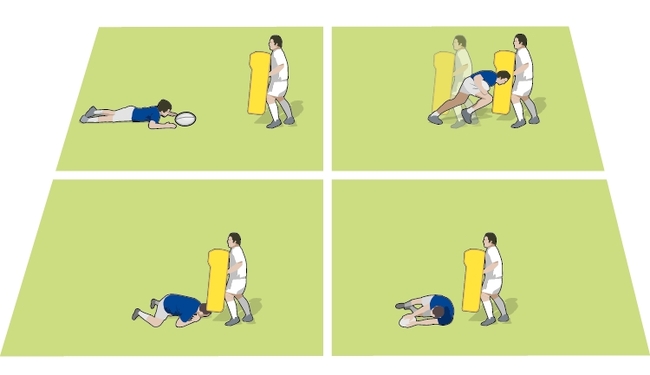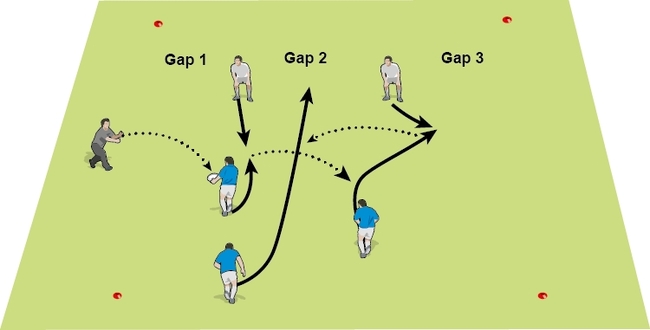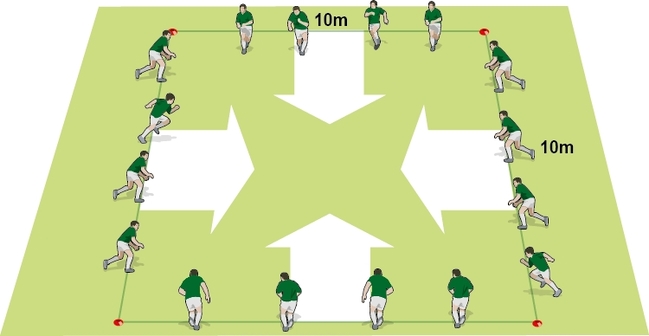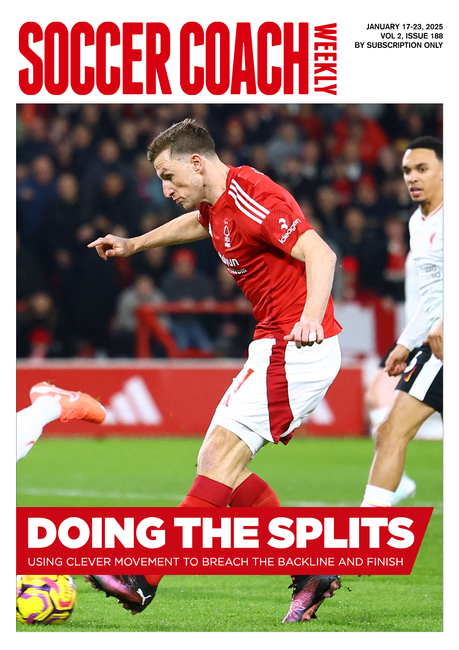Jumble up defences with your kicking game
Tacticsby Ian Foster
Kicking tactics have changed. With more players in the backfield covering kicks, you now need to savvier with your kicking game.
A kicking game is still a key way to jumble up defences. However, defences are staying out of rucks and spreading across the field, thus allowing more players in the backfield. With more players behind the first line of defence, there is less space to kick to.
These two factors have meant that kicking has to be more accurate. We cannot get away with kicking the ball long without an excellent chase. We have to think about where we are kicking.
For instance, cross kicks (wipers) kick away from the major chasing groups. You might only have a winger and centre near the ball. That opens up a channel for the opposition to run back, and makes it harder to pressurise the counter-attack. Plus, who is going to cover behind this limited defence. Now kicking tactics are about finding spaces behind the defence. The key is where we are on the field.
As a general principle, when you are in our 22m area, you want to kick long and let them play back. So we generate pressure in the kick chase to make them kick back.
The best kick comes from 9 at the base of the ruck. Otherwise, the chase is at least five metres slower. The forwards have to wait until the kicker, or one of the chasers next to the kicker, has run passed them. This waiting period is longer if the ball is passed back to a kicker behind the ruck or set-piece.
Tactically, I tend to play two rucks from a set-piece, especially a scrum, to flatten the chase. This allows the backs and more of the forwards to be behind the kicker and ready to move up from an onside position.

Flatten the chase by kicking from 9. In your 22m area, it is better to kick from the back of the ruck. First, 9 is further up the field than 10, so won't need to kick as far to generate the same distance. Second, it takes time to pass and receive the ball at 10, putting more pressure on 10 to kick. Third, the chasers are further up the field with more players onside sooner.
In the area from the 22m line to the halfway line, you can use the kicking game to shape defences and not necessarily to relieve pressure.
For instance, early in the game, you can kick to push their wingers back. Now the 22m line to their halfway line becomes a good attack area. If their back three is deeper, then we play with the ball in hand. If their back three is up, then we kick.
It is like a chess game, pushing and probing. Crucially, mix it up. Don't kick every time, vary the kicks.
Kicking tactics are weather and opposition dependent. Even with highly skilled players and better ball technology, a high ball on a wet and windy day is difficult to catch.
You can build this into your analysis of the type of decision that the opposition will make when we are kicking.
As a team, you need to execute ALL types of kicks to jumble up defences. That means high balls, cross kicks, chips, grubbers. The opposition cannot cover all the spaces on the pitch and you cannot let them know where to cover.
Our 9/10/12 have a great responsibility to kick. They need to see what is in front of them and react to that. But to do that effectively, you need a system in place. If there is a space left by the defence, who will kick to that space and when?
We also know that defences are 'selling' a place on the pitch. Canny teams are showing you a space, inviting you to kick, and then filling it at the last moment.
The winger will start up in the line from a set-piece and then drift back as the ball is put into the scrum. Too early a call to kick will then lead to a kick to the winger, who is now in position, ready to take the ball.
To counter this, work hard at getting the players to call from the outside. This means wingers and full back play a greater role in this part of the game. Traditionally, they had non-decision making roles. Now, they not only have to call what they see, but also take the rap if it is the wrong decision, just as much as 10 might do if he runs when he should have kicked.
From a coaching and team point of view, the rewards from giving the players more responsibility can be great and very motivating. In my experience, we create more scoring opportunities by asking more players to take responsibility for seeing and understanding where the space is.
Show the opposition where to kick and then take the space

Some sides are deliberately showing attacking teams spaces into which to kick. When the set piece starts, the defending wingers come up the field.
The attacking 9 or 10 sees this space and decides to kick into it rather than run.
As the ball goes into the scrum (or lineout), the wingers move back, so when the kick comes, they are in a position to take the ball.

A kicking game is still a key way to jumble up defences. However, defences are staying out of rucks and spreading across the field, thus allowing more players in the backfield. With more players behind the first line of defence, there is less space to kick to.
These two factors have meant that kicking has to be more accurate. We cannot get away with kicking the ball long without an excellent chase. We have to think about where we are kicking.
For instance, cross kicks (wipers) kick away from the major chasing groups. You might only have a winger and centre near the ball. That opens up a channel for the opposition to run back, and makes it harder to pressurise the counter-attack. Plus, who is going to cover behind this limited defence. Now kicking tactics are about finding spaces behind the defence. The key is where we are on the field.
KICKING OUT OF THE 22M
As a general principle, when you are in our 22m area, you want to kick long and let them play back. So we generate pressure in the kick chase to make them kick back.
The best kick comes from 9 at the base of the ruck. Otherwise, the chase is at least five metres slower. The forwards have to wait until the kicker, or one of the chasers next to the kicker, has run passed them. This waiting period is longer if the ball is passed back to a kicker behind the ruck or set-piece.
Tactically, I tend to play two rucks from a set-piece, especially a scrum, to flatten the chase. This allows the backs and more of the forwards to be behind the kicker and ready to move up from an onside position.

Flatten the chase by kicking from 9. In your 22m area, it is better to kick from the back of the ruck. First, 9 is further up the field than 10, so won't need to kick as far to generate the same distance. Second, it takes time to pass and receive the ball at 10, putting more pressure on 10 to kick. Third, the chasers are further up the field with more players onside sooner.
KICKING FROM THE 22M TO HALFWAY
In the area from the 22m line to the halfway line, you can use the kicking game to shape defences and not necessarily to relieve pressure.
For instance, early in the game, you can kick to push their wingers back. Now the 22m line to their halfway line becomes a good attack area. If their back three is deeper, then we play with the ball in hand. If their back three is up, then we kick.
It is like a chess game, pushing and probing. Crucially, mix it up. Don't kick every time, vary the kicks.
READ THE WEATHER AND THE OPPOSITION
Kicking tactics are weather and opposition dependent. Even with highly skilled players and better ball technology, a high ball on a wet and windy day is difficult to catch.
You can build this into your analysis of the type of decision that the opposition will make when we are kicking.
- Where will they stand to field kicks?
- How will they counter? Will they kick or run? In any event they will change their tactics depending on the weather conditions.
PLAYING THE KICKING GAME
As a team, you need to execute ALL types of kicks to jumble up defences. That means high balls, cross kicks, chips, grubbers. The opposition cannot cover all the spaces on the pitch and you cannot let them know where to cover.
Our 9/10/12 have a great responsibility to kick. They need to see what is in front of them and react to that. But to do that effectively, you need a system in place. If there is a space left by the defence, who will kick to that space and when?
We also know that defences are 'selling' a place on the pitch. Canny teams are showing you a space, inviting you to kick, and then filling it at the last moment.
The winger will start up in the line from a set-piece and then drift back as the ball is put into the scrum. Too early a call to kick will then lead to a kick to the winger, who is now in position, ready to take the ball.
To counter this, work hard at getting the players to call from the outside. This means wingers and full back play a greater role in this part of the game. Traditionally, they had non-decision making roles. Now, they not only have to call what they see, but also take the rap if it is the wrong decision, just as much as 10 might do if he runs when he should have kicked.
From a coaching and team point of view, the rewards from giving the players more responsibility can be great and very motivating. In my experience, we create more scoring opportunities by asking more players to take responsibility for seeing and understanding where the space is.
Show the opposition where to kick and then take the space

Some sides are deliberately showing attacking teams spaces into which to kick. When the set piece starts, the defending wingers come up the field.
The attacking 9 or 10 sees this space and decides to kick into it rather than run.
As the ball goes into the scrum (or lineout), the wingers move back, so when the kick comes, they are in a position to take the ball.

Newsletter Sign Up
Coaches Testimonials

Gerald Kearney, Downtown Las Vegas Soccer Club

Paul Butler, Florida, USA

Rick Shields, Springboro, USA

Tony Green, Pierrefonds Titans, Quebec, Canada
Subscribe Today
Be a more effective, more successful rugby coach
In a recent survey 89% of subscribers said Rugby Coach Weekly makes them more confident, 91% said Rugby Coach Weekly makes them a more effective coach and 93% said Rugby Coach Weekly makes them more inspired.
Get Weekly Inspiration
All the latest techniques and approaches
Rugby Coach Weekly offers proven and easy to use rugby drills, coaching sessions, practice plans, small-sided games, warm-ups, training tips and advice.
We've been at the cutting edge of rugby coaching since we launched in 2005, creating resources for the grassroots youth coach, following best practice from around the world and insights from the professional game.

